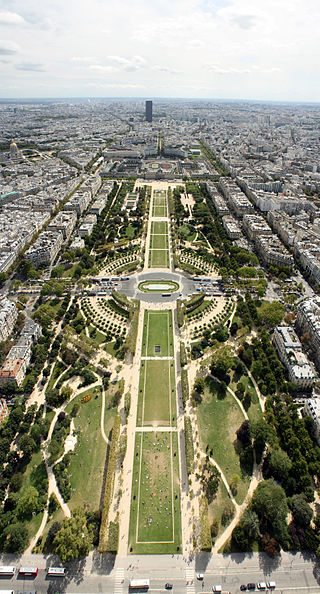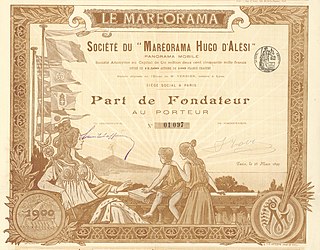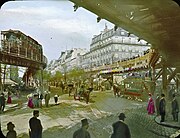
The Champ de Mars is a large public greenspace in Paris, France, located in the seventh arrondissement, between the Eiffel Tower to the northwest and the École Militaire to the southeast. The park is named after the Campus Martius in Rome, which was dedicated to the god Mars. The name alludes to the fact that the lawns here were formerly used as drilling and marching grounds by the French military.

The Exposition Universelle of 1855, better known in English as the 1855 Paris Exposition, was a world's fair held on the Champs-Élysées in Paris, France, from 15 May to 15 November 1855. Its full official title was the Exposition Universelle des produits de l'Agriculture, de l'Industrie et des Beaux-Arts de Paris 1855. It was the first of ten major expositions held in the city between 1855 and 1937. Nowadays, the exposition's sole physical remnant is the Théâtre du Rond-Point des Champs-Élysées, designed by architect Gabriel Davioud, which originally housed the Panorama National.

A moving walkway, also known as an autowalk, moving pavement, moving sidewalk, people-mover, travolator, or travelator, is a slow-moving conveyor mechanism that transports people across a horizontal or inclined plane over a short to medium distance. Moving walkways can be used by standing or walking on them. They are often installed in pairs, one for each direction.

The Exposition Universelle of 1900, better known in English as the 1900 Paris Exposition, was a world's fair held in Paris, France, from 14 April to 12 November 1900, to celebrate the achievements of the past century and to accelerate development into the next. It was the sixth of ten major expositions held in the city between 1855 and 1937. It was held at the esplanade of Les Invalides, the Champ de Mars, the Trocadéro and at the banks of the Seine between them, with an additional section in the Bois de Vincennes, and it was visited by more than fifty million people. Many international congresses and other events were held within the framework of the exposition, including the 1900 Summer Olympics.

The Exposition Universelle of 1878, better known in English as the 1878 Paris Exposition, was a world's fair held in Paris, France, from 1 May to 10 November 1878, to celebrate the recovery of France after the 1870–71 Franco-Prussian War. It was the third of ten major expositions held in the city between 1855 and 1937.

Gare d'Austerlitz, officially Paris Austerlitz, is one of the seven large Paris terminal stations. The station is located on the left bank of the Seine in the southeastern part of the city, in the 13th arrondissement. It is the start of the Paris–Bordeaux railway; the line to Toulouse is connected to this line. In 1997, the Ministry of Culture designated the Gare d'Austerlitz a historical monument; it became the fifth large railway station in Paris to receive such a label, as currently only Montparnasse has not been attributed it.

Miromesnil is a station on Line 9 and Line 13 of the Paris Métro in the 8th arrondissement.

The Exposition Universelle of 1889, better known in English as the 1889 Paris Exposition, was a world's fair held in Paris, France, from 5 May to 31 October 1889. It was the fifth of ten major expositions held in the city between 1855 and 1937. It attracted more than thirty-two million visitors. The most famous structure created for the exposition, and still remaining, is the Eiffel Tower.

Musée d'Orsay is a station in line C of the Paris Region's Réseau express régional (RER) rapid transit system, named after the Musée d'Orsay, housed in the old Gare d'Orsay. It is in the 7th arrondissement of Paris. It was one of several stations attacked during the 1995 Paris Métro and RER bombings.

Champ de Mars–Tour Eiffel station is a station on RER C in Paris named for the nearby Champ de Mars and Eiffel Tower.

Paris Métro Line 8 is one of the sixteen lines of the Paris Métro. It connects Balard in the southwestern part of Paris to Pointe du Lac station in the southeastern suburbs, following a parabolic route on the Rive Droite of the Seine. The last line of the original 1898 Paris Métro plan, which opened in July 1913, it was initially intended to link Porte d'Auteuil and Opéra. With 105.5 million travellers in 2017, it is the network's eighth busiest line; at 23.4 km (14.5 mi) in length, it is also the second longest Métro Line after Line 13, and the longest fully straight line, as line 13 has branches. Along with Line 7, it serves the most stations of any line on the network, at 38. Line 8 interchanges with all but three other Métro lines.

Paris's former Chemin de fer de Petite Ceinture, also colloquially known as La Petite Ceinture, was a circular railway built as a means to supply the city's fortification walls, and as a means of transporting merchandise and passengers between Paris' major rail-company stations. Beginning as two distinct 'Ceinture Syndicate' freight and 'Paris-Auteuil' passenger lines from 1851, these lines formed an arc that surrounded the northern two thirds of Paris, an arc that would become a full circle of rail around the capital when its third Ceinture Rive Gauche section was built in 1867.

The Exposition Universelle of 1867, better known in English as the 1867 Paris Exposition, was a world's fair held in Paris, France, from 1 April to 3 November 1867. It was the second of ten major expositions held in the city between 1855 and 1937. A number of nations were represented at the fair. Following a decree of Emperor Napoleon III, the exposition was prepared as early as 1864, in the midst of the renovation of Paris, marking the culmination of the Second French Empire. Visitors included Tsar Alexander II of Russia, a brother of the King William and Otto von Bismarck of Prussia, Prince Metternich and Franz Josef of Austria, Ottoman Sultan Abdülaziz, and the Khedive of Egypt Isma'il.

The Mareorama was an entertainment attraction at the 1900 Paris Exposition. It was created by Hugo d'Alesi (fr), a painter of advertising posters, and was a combination of moving panoramic paintings and a large motion platform. It is regarded as one of the last major developments in the technology of panoramas, shortly before the medium became obsolete.

The Brussels International Exposition of 1910 was a world's fair held in Brussels, Belgium, from 23 April to 1 November 1910. This was just thirteen years after Brussels' previous world's fair. It received 13 million visitors, covered 88 hectares and lost 100,000 Belgian francs.

The Galerie des machines was a pavilion built for the 1889 Exposition Universelle in Paris. Located in the Grenelle district, the huge pavilion was made of iron, steel and glass.
Paris Exposition, 1900 was a series of seventeen short French silent actuality films made in 1900 by Georges Méliès. The series was a documentary record of the 1900 Exposition Universelle in Paris.
Paris Métro Line 17 is one of four lines of the Grand Paris Express. It is planned to open in phases from 2026 through 2030. Sections will be above ground, including Parc des Expositions station.

The Decauville railway at Exposition Universelle (1889) was a 3 km (1.9 mi) long 600 mm gauge railway line, which operated during the Exposition Universelle world fair from 6 May to 31 October 1889 from Esplanade des Invalides to Avenue de Suffren in Paris.

The Royal Pavilion of Spain was the exhibition national pavilion of the Kingdom of Spain at the 1900 Paris Universal Exposition. It was a temporary building by architect José Urioste Velada in Neo-Plateresque style located on the Quai d'Orsay. It housed a Retrospective Exhibition of Spanish Art, the Royal Office of the Spanish Commissioner at the Fair and the first restaurant in History with a completely electric kitchen.























